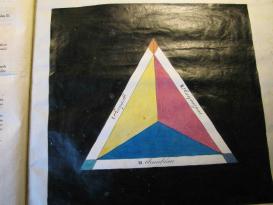Color was long excluded from the “characters” or “differentiae” used to describe species and thus to distinguish species from each other. For late eighteenth and early nineteenth-century artists working in watercolor and related media (Philip Otto Runge, Mary Gartside, Edward Bancroft, Moses Harris, James Sowerby, Johannes Lambert, Matthias Klotz), color looked like an instance of what Hans-Jörg Rheinberger describes as the “unstable,” “strange and facile reality of scientific objects,” something akin to an epistemic thing whose nature and usefulness European artists and theorists of this era repeatedly redefined, in the midst of debates about the relationship of prismatic color to so called “natural” colors, meaning both colors found in the phenomenal world and those created as pigments from vegetable or mineral materials. In treatises by German, French, and English writers whose arguments that Theresa M. Kelley began to study during her time at the MPIWG, claims about color shift unsteadily from material pigments to accounts of prismatic colors. Across these works, the object-ness of color, its putative materiality, is consistently at issue in ways that specify shifting, ongoing history of objects of knowledge.
As modern historians of color theory have done, Kelley framed this inquiry on one end by thinking, as color theorists of this period always did, in terms of Newton’s Opticks (1709), with one key difference. Kelley was more interested in Newton’s early experimental papers on prismatic color, which display an attention to material color that is surprising, given the focus on the prismatic spectrum in the later Opticks. The other end of her argument concerned Goethe’s deliberately controversial Farbenlehre (1810), which reiterates, albeit more sharply than earlier theorists had done, a resistance to Newton’s prismatic theory that turns on its inattention (as Goethe saw it) to material color and phenomenal disturbances (or interventions) that alter or change color. Kelley's approach differed from that of recent historians who have summarized color theory from Newton (1665–1709) to the Young-Maxwell-Helmholtz synthesis (1852).
Paul Sherman and more recently Rolf Kuehni and Andreas Schwartz, editors of the recent Color Ordered, present the color systems of this period as evidence of a repeated, stubborn confusion of spectral, that is prismatic color, with material pigments, a confusion that was only and finally addressed by Maxwell and Helmholtz, who also confirmed Thomas Younger’s earlier hypothesis of the wave theory of light. As Kelley read it, the inner logic of this confusion suggests an entanglement of epistemic, aesthetic and material concerns that swirl or eddy beneath the history of color as a scientific and philosophical object. What appears to sustain this confusion is a disposition toward what might be called the material aesthetics of color, by which she means an adhesive attraction to colors, materials and pigments among artists and others involved in manufacturing color in different media, equally at issue when the question of prismatic color is also on the table. The phrase is less valuable than what it indicates: a tenacious absorption in the materiality of color that carries an aesthetic charge, conveyed in part by the desire to match colors in nature with pigment and the color spectrum. For these artists and for Goethe, no mean artist himself, thinking about color required experimenting with material properties and, further, granting these properties a degree of aesthetic value that slips a little from view in the line of reasoning, that is the main line of scientific development, from Newton to Helmholtz. What several of these manuals suggest, and what Goethe more emphatically insists on in the Farbenlehre essay, is a way of thinking about color as at once epistemic, aesthetic, material, and fugitive.

